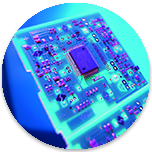____________________________________
Industrial Liaison Group:
Tel: +44 (0) 1235 778797
E-mail: industry@diamond.ac.uk
The electronics sector continuously strives to develop and launch new high technology products that advance society. Being able to manipulate nanoparticles and studying magnetism on the nanoscale have potential for building materials atom by atom, allowing engineering with unprecedented precision. Therefore, understanding matter at the nanometre scale is crucial for design of electronic materials and devices with finely tuned properties and behaviours for a huge range of applications.
Diamond’s facilities are unique in the world providing a range of research techniques that will enable electronics companies to exploit fully the new and emerging technologies of the 21st century.

Electronic Structures
Magnetism
Composition
Organic Electronics





Transparent conducting films are an important component of modern life, providing optically transparent and electrically conductive material for a wide range of devices, such as smart phones, touchscreens and solar panels. The field’s most widely used material is tin-doped In2O3 (ITO), accounting for 60% of both global indium use and the transparent conductor market. However, indium is expensive, so there is strong demand for a cheaper alternative or a way to use less indium.
Read more...Titanium dioxide is one of the most widely used metal oxides and in recent years it has attracted increasing attention in the form of thin films for applications in microelectronics. In particular, it has found potential application in resistive random access memory (RRAM) cells, where the titanium dioxide active layer is sandwiched between two metal electrodes in a metal-insulator-metal (MIM) device architecture. Because of their simple structure, RRAM cells, also known as memristors, can be incorporated into devices with high density that function at low power and high speed. The importance of RRAM devices is due to the fact that they exhibit resistive switching; i.e., they have the ability to toggle their corresponding resistance between high and low resistance states by application of an appropriate voltage. However, this resistive switching mechanism is not currently well understood and is still a matter of debate.
Read more...
Liquid crystal displays (LCDs) are currently very inefficient in terms of energy use. An electric field governs the direction of the liquid crystal molecules (which switches each pixel on or off) but currently a combination of polarisation filters and colour filters are used to view each pixel and provide colour. Each of these filters also block some of the light. The result is that only approximately 9% of the backlight is emitted from the display itself so is important to find alternative ways of controlling pixels and colour in LCD displays to reduce cost and energy consumption.
Read more...Diamond Light Source is the UK's national synchrotron science facility, located at the Harwell Science and Innovation Campus in Oxfordshire.
Copyright © 2022 Diamond Light Source
Diamond Light Source Ltd
Diamond House
Harwell Science & Innovation Campus
Didcot
Oxfordshire
OX11 0DE
Diamond Light Source® and the Diamond logo are registered trademarks of Diamond Light Source Ltd
Registered in England and Wales at Diamond House, Harwell Science and Innovation Campus, Didcot, Oxfordshire, OX11 0DE, United Kingdom. Company number: 4375679. VAT number: 287 461 957. Economic Operators Registration and Identification (EORI) number: GB287461957003.